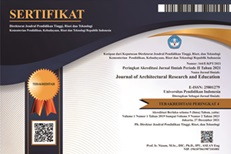Exploring the Architectural-identity of Bali Post Hasta Kosala Kosali
Abstract
As the product of culture and the background of human activities, architecture that constructs place-identity are in a state of constant modification. This paper explores the dynamic development of architecture of a vernacular landscape since the time when external power of colonialization introduced new ideas, techniques and construction methods to the more traditional know how. A case study in Bali is analyzed through historical research involving document and policy analysis, in depth interview with key informants, observation and building surveys. The result shows that prior to colonization era, the island was developed based on local building codes called Hasta Kosala-Kosali that is written on traditional lontar leaf manuscripts. New political system as well as business interests are two main factors influencing the transformation of architectural-identity of the island in the colonial and post-colonial era to date. The physical identity is among the main charms of the Island of Bali. In order to maintain the attractiveness of the island, the public and private sector should work together with the community in establishing policies regarding the physical development of Bali.
Keywords: Architectural identity, tradition, post-colonialism, hasta kosala-kosali
Full Text:
PDFReferences
Akihary, H. (2006). Ir. F. J. L. Ghijsels: Architecture in Indonesia. Alphen aan den Rijn : Seram Press.
Anderson, B. (1998). Imagined Communities: Reflections on the origin and spread of nationalism (Revised edition ed.). London: Verso.
Ardhana, I. K. (2019). Denpasar: Perkembangan dari kota kolonial hingga kota wisata. In F. Colombijn, M. Barwegen, P. Basundoro, & J. A. Khusairy, Kota lama kota baru: Sejarah kota-kota di Indonesia (pp. 377-396). Yogyakarta: Ombak.
Bourdier, J., & Alsayyad, N. (1989). Dwellings, settlements and tradition: Cross-cultural perspectives. Lanham: University of Minnesota.
Coast, J. (2004). Dancing out of Bali, first published in 1953. Singapore: Tutle publishing.
Colombijn, F. (2006). Planning and social tension in Indonesian cities. Global Bioethics, 19(1), 73-84.
https://www.tandfonline.com/doi/abs/10.1080/11287462.2006.10800886
Cote, J., & O'Neill, H. (2017). The life and work of Thomas Karsten. Amsterdam: Architectura & Natura.
Couteau, J. (1999). Museum Puri Lukisan Ubud. Ubud: Yayasan Ratna Warta.
Darling, D. (2012). Tandjung Sari: A magical door to Bali. Singapore: Edition Didier Millet.
EFD, P. S. (1935). Verkoopster van etenswaren op Bali. KITLV 1400177. Leiden, Leiden, Netherlands. Retrieved 2019, from http://hdl.handle.net/1887.1/item:776418
Eiseman, F. B. (1990). Bali: Sekala and niskala: Essays on relogion, ritual and art. North Clarendon: Tutle Publishing.
Gelebet, N. (1984). Arsitektur Tradisional Daerah Bali. Jakarta: Depdikbud.
Helmi, R., & Walker, B. (1995). Bali Style. London: Thames and Hudson.
Jenkins, R. (1996). Social Identity. London: Routledge.
Kersten, J. (1947). Bali. Eindhoven: Uitgeversmaatschappij de Pelgrim NV.
King, A. D. (1991). Culture, globalisation and the world system: contemporary conditions for the representations. London: Palgrave MacMillan.
Kropf, K. (2009). Aspect of urban form. Urban Morphology, 13(2), 105-120.
https://www.researchgate.net/publication/289348372_Aspects_of_urban_form
Kusno, A. (2000). Behind the postcolonial: Architecture, urban space and political cultures in Indonesia. New York: Routledge.
Kusno, A. (2012). Homogeneity of representations: Salvation or menace. In M. Sadria, Homogeneity of representations (pp. 153-166). Geneve: Aga Khan Award for Architecture.
https://archnet.org/authorities/3262/publications/7210
Kusno, A. (2013). After the new order: Space, politics, and Jakarta. Hawaii: University of Hawaii Press.
Leiden, D. C. (1920). Bali Hotel. Leiden, Leiden, Netherlands. Retrieved from http://hdl.handle.net/1887.1/item:765803
Madanipour, A. (2013). The identity of the city. In S. Serreli, Urban and landscape perspective 14: City project and public space. Dordrecht: Springer.
Moojen, P. A. (1926). Kunst op Bali. Bandung: Adi Poestaka.
Nieuwenkamp, W. O. (1910). Bali en Lombok. Amsterdam: Elsevier.
Nieuwenkamp, W. O. (1910). Bouwkunst van Bali. HP Leopold Ed. Me: The Hague.
Nordholt, H. S. (2011). Indonesia in the 1950's: Nation, modernity, and the post-colonial state. Bijdragen tot de Taal, Land-en Volkenkunde, 386-404.
https://www.researchgate.net/publication/254831597_Indonesia_in_the_1950s_Nation_modernity_and_the_post-colonial_state
Oliver, P. (2007). Dwellings: the vernacular house worldwide. London: Phaidon Press.
Passchier, C. (2009). Colonial architecture in Indonesia. In P. J. Nas, & M. d. Vletter, The past in the present: Architecture in Indonesia (pp. 121-143). Rotterdam: NAI Publisher.
Passchier, C. (2016). Building in Indonesia 1600-1960. Volendam: LM Publishers.
Pearson, C. (1998). Indonesia Design and Culture. New York : Monacelli Press.
Picard, M. (1997). Bali: Cultural tourism and touristic culture. Singapore: Archipelago Press.
Powell, H. (1982). The last paradise: An American discovery of Bali in the 1920s (Oxford University Press paperback ed.). Oxford: Oxford University Press.
Relph, E. (1976). Place and placelesness. London: Pion Limited.
Robson, D. (2002). Geoffrey Bawa: The complete works. London: Thames and Hudson.
Sastrowardoyo, R. S. (1987). A brief introduction to traditional architecture of Bali: Some basic norm. Denpasar: PT. Atelier 6.
SCETO. (1974). Bali Tourism Masterplan. Paris: UNDP/IBRD.
Sepe, M. (2013). Planning and place in the city: Mapping place-identity. New York: Routledge.
Sepe, M., & Pitt, M. (2014). The characters of place in urban design. Urban Design International, 215-227.
https://link.springer.com/article/10.1057%2Fudi.2013.32
Southworth, M., & Rugerri, D. (2010). Beyond placelessness: Place-identity and the global city. In T. Banerjee, & A. Loukaitou-Sideris, Companion to Urban Design (pp. 495-509). London: Routledge.
Stowel, J. (2012). Walter Spies: a life in art. Jakarta: Afterhours.
Tan, R. (1967). The domestic architecture of South Bali. Bijdragen tot de Taal‐, Land‐en Volkenkunde, 422-475.
https://www.researchgate.net/publication/41018305_The_domestic_architecture_of_South_Bali
Tjahjono, G., & Miksic, J. N. (2003). Architecture: The Indonesian Heritage Series. Singapore: Archipelago Press.
Tropenmuseum, R. T. (1900-1960, - -). VI/486. Pasanggrahan te Gitgit Singaradja (Bali). Retrieved from http://colonialarchitecture.eu: http://colonialarchitecture.eu/obj?sq=id%3Auuid%3Adefa1256-5822-46ba-a13f-5d0dc0892ee6
Tropenmuseum, R. T. (1900-1960, - -). VI/487. Bali gouvernements pasanggrahan te Kintamani. Amsterdam. Retrieved from http://colonialarchitecture.eu/obj?sq=id%3Auuid%3A8fb1cbe7-016e-4b18-b930-2793d4c69bf3
Vickers, A. (1994). Travelling to Bali: Four hundred years of journeys. Singapore: Oxford University Press.
Vickers, A. (2012). Bali: A paradise created. Singapore: Tuttle Publishing.
Watson, G. B., & Bentley, I. (2007). Identity by Design. London: Architectural Press.
Whitehand, J. W. (2009). The structure of urban landscapes: strengthening research and practice. Urban Morphology, 13(1), 5-27.
http://www.urbanform.org/online_public/2009_1.shtml
Whitehand, J. W. (2012). Issues in urban morphology. Urban Morphology, 16(1), 55-65.
https://www.researchgate.net/publication/286868244_Issues_in_urban_morphology
Wijaya, M. (1984). Balinese architecture: Towards an encyclopaedia. Denpasar: Wijaya Words.
DOI: https://doi.org/10.17509/jare.v1i2.22309
Refbacks
- There are currently no refbacks.
Copyright (c) 2020 I Nyoman Gede Maha Putra

This work is licensed under a Creative Commons Attribution-NonCommercial-ShareAlike 4.0 International License.

This work is licensed under a Creative Commons Attribution-ShareAlike 4.0 International License.








